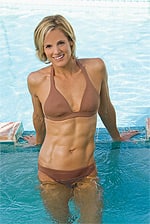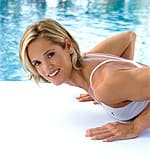Life Extension Magazine®
Olympic swimming icon Dara Torres talks to Life Extension® about ignoring your age, the power of amino acids, and her quest to make the 2012 Olympics as a 45-year-old. “The water doesn’t know how old you are.”This was the mantra of 5-time Olympian Dara Torres in the lead-up to the 2008 Olympics in Beijing, China. Substitute your goals for the word “water” in this now famous quote and it could become your personal mantra as well. If you’re thinking about taking up running,“the road doesn’t know how old you are” applies to you. Same goes for the grass on a golf course; or the clay on a tennis court; or if you’ve always wanted to learn an instrument, a piano or guitar doesn’t know how old you are either. Torres’ quote is full of limitless possibilities, but its weight is grounded in the concrete achievement of her performance at the 2008 Olympic Games, where, as a 41-year-old mother, she won three silver medals—one of them a mere one one-hundredth of a second from being a gold. All told, the three medals Torres won at the 2008 games brought her lifetime Olympic medal total to twelve (including three gold medals). With an Olympic career that has spanned 24 years, there have been innumerable “firsts” for which she is famous, but the one that garnered her the most attention was the achievement of becoming the first woman in history to make an Olympic swim team past the age of 40. In a sport where women are often crowned world champions before they are old enough to be crowned prom queen, what Torres has done simply defies what we thought we knew about the limits of the aging human body. Outsmarting father time
“At my age, you can’t just wake up every morning and assume that you have recovered from the previous day’s workout,” Torres says. “The water doesn’t know my age, so I don’t get any breaks. That was my philosophy and my guiding light. I have to be smarter about what I do now than when I was younger. I need to be more focused and conserve my energy for maximum efficiency.” For those unfamiliar to the way swimmers train, this last concept of conserving energy for maximum efficiency is particularly important. When training for a major meet, swimmers often log over 10,000 meters a day in the pool, usually in a morning and afternoon session, with a dry land workout mixed in three or four days a week. Swimmers need to build up a powerful aerobic base so that they can hold perfect form throughout an entire race. Fatigue is the single biggest enemy of perfect form, which is why swimmers bank so many meters each day. The idea is to eliminate fatigue from the racing equation as much as possible in order to focus on the things that win races: powerful starts, efficient strokes, flawless turns, and well-timed wall touches, among the most critical. When Torres talks about conserving energy, she’s talking about recognizing how her body has changed over the years and how it responds to training. There’s no point in hammering away at the same workout she did in her twenties if the body she has in her forties won’t respond well to it. The key is to constantly evaluate what currently works, not what worked last week, last month, or last year. For Torres, that evaluation has led to a renewed focus on the details. Reaching these small, daily goals helps Torres get one step closer to achieving bigger goals, like winning Olympic medals.
“My training now is much more razor-focused on replicating my stroke in the water,” she says. “My trainer, Andy O’Brien, and my coaches have all created a very high-level program where I waste no time, energy, and effort. I do everything with a purpose. Everything has a goal in mind.” Reaching these small, daily goals helps Torres get one step closer to achieving the bigger goals, like winning Olympic medals. To ward off the monotony of performing the thousands and thousands of daily repetitions of tiny movements in the water that are necessary to swim the perfect race, Torres finds inspiration in a number of places, from her own mother to mothers across the world. Motherly motivation
“I look at mothers all over the world who I have met and when they tell me their stories they move me in a way that is so intense,” Torres says. “I am part of a community that includes businesswomen, sportswomen, housewives, teachers, doctors, and mothers. Each and every one of them has their dreams.” Whatever your particular dream is, the overall theme of Torres’ philosophy is that age should never be a reason not to achieve it. “As long as someone has a passion, a desire to be the best, I say they should have that opportunity,” she says. “I draw on the passion of women like my mother and other great women who continue to achieve excellence at any age.” The flip side of this, of course, is that millions of women look to Torres for their own inspiration, making the relationship between her and her fans a symbiotic one. “It is insanely flattering how many women want to share with me what watching my journey meant to them and how it has changed their lives,” she says. “Or when I hear how they bought one of my books, Age is Just a Number or Gold Medal Fitness because I motivated them. My Twitter following has exploded (@daratorresswims) and I can share my life in a real, honest way. And my fans can communicate back to me.” Among this communication is her announced desire to compete as a 45-year-old in the 2012 Olympic Games in London, England. “The truth is, in many ways I feel like 2012 is my opportunity to give back to so many women and moms who have given to me emotionally through a short comment or e-mail,” Torres says.
The road to 2012
Just as Torres’ training has evolved through the years, so has her nutrition and eating habits. Like many athletes, she didn’t have a specific “diet” when she first started training as a teenager. The main goal at that age was to eat as much as she could to fuel the next workout. Our knowledge about how to use foods as part of training and recovery has improved exponentially over the years, which is why Torres now pays close attention to what she eats. “When I was younger, I ate anything that was put in front of me,” she says. “I am still not a ‘dieter’ but I am more aware of what I put into my body. Fitness Nutrition’s Amino Acids have become a huge factor in my recovery. I have also changed over to Susta, which is an all-natural sweetener. I have learned that you should eat sensibly but nothing too extreme. Living healthy is also about living happily.” Living happily in 2012 will mean making the United States Olympic Swim Team at an age when many of the women Torres swam against in her supposed “prime” have been retired for twenty-five years. We’ll have to wait to find out whether she succeeds in making the team, but one thing’s for certain: whether she’s in London at the end of next July or not, Torres has already succeeded in proving that age, truly, is just a number.
|






